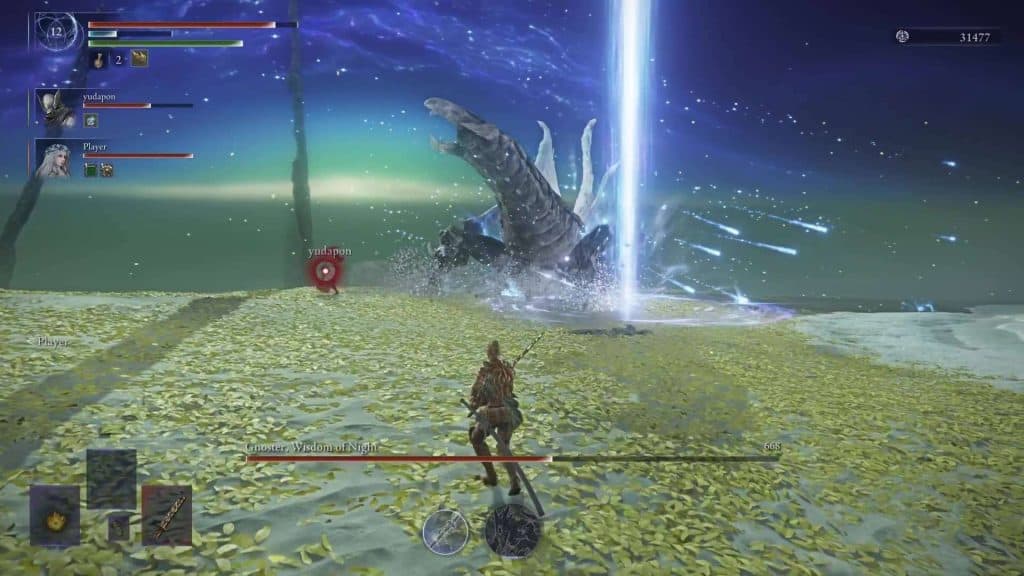Among the creepy emptiness of Elden Ring: Nightreign, few fights are as unsettling and strategically demanding as that of Gnoster, Wisdom of Night, or the Sentient Pest. This two-entity Nightlord is a real test, blending airborne magic assault with relentless ground-dwelling melee.
For all those who want to conquer this boss and make their way through the perilous lands of Limveld, it is critical to be familiar with the mechanics and vulnerabilities of Gnoster!
Knowing Gnoster: The Dual Threat

Gnoster is not a single beast but a combination of two separate beasts: a giant moth that dominates the skies with potent magic and a heavily armored scorpion that takes over the ground using brute force. This introduces an interactive battlefield where players have to be adaptive in reacting against threats from above and from below. Having a two-in-one boss fight makes it one of the more unique bosses in Nightreign!
The moth employs ranged magical attacks, like poison gas and projectile-guided missiles, designed to confuse and obliterate at a distance. Meanwhile, the scorpion rolls in with blunt melee attacks, aiming to overwhelm players in close combat. Coordinating the two forms demands more attention and tactical positioning.
Preparation: Gear and Strategy
1. Fire-Based Arsenal
Both moth and scorpion versions of Gnoster have a significant vulnerability to fire. Fighting with fire-infused weapons or using Fire Grease can increase your damage dealt quite a lot. Classes such as the Wylder, who are fire-elementalist in nature, perform exceptionally well in this fight.
2. Stock Up on Poison Resistance
The moth’s poison attack can quickly suck health and slow movement. A Neutralizing Bolus is required to counter poison buildup and remain fight-effective.
3. Choose Agile Classes
Agile classes such as the Recluse, Ironeye, or Revenant offer mobility to quickly dodge attacks and reposition. Their agility is key when handling the double-menace terrain of the Sentient Pest.
Combat Tactics: Navigating the Battle
Phase One: Dual Assault
At the start, Gnoster’s scorpion and moth forms act separately. The moth floats, casting spells from the air, and the scorpion attacks directly. Prioritize separating and destroying the scorpion first, since its ground position is an instant threat. Use the terrain to protect against air attacks while sending the scorpion packing.
Phase Two: Unified Onslaught
Once having brought Gnoster’s health down to about halfway, both forms combine, making the fight more intense. As a combined form, it attacks relentlessly, mixing the moth’s magic with the scorpion’s body. A balance must be maintained between defense and offense, as it attacks fire weakness and avoids complicated patterns of attack.
Things To Watch Out For
Moth

- When it is in the air, anything and everything can happen. It is good practice to prepare to dodge!
- Its toxic fume is not very good for you, so stay away from it when it’s closer to you!
- The moth can attempt to grab you! It will fly left and then towards the right, and then it will charge towards you.
Scorpion

- If it burrows beneath the ground, watch the sand, and you can know where or whom it’s targeting!
- Most of its slam attacks will attack forwards towards you, so try dodging into the scorpion. Seems counterintuitive, yes, but when it slams, dodge towards it!
- If you’re next to it, especially its legs, get ready for it to try to stomp!
Rewards for Defeating Gnoster
After defeating Gnoster, Wisdom of Night, the Night of the Wise relic is rewarded. This excellent item increases your ability by boosting maximum FP, making your initial armament poison your enemies, and strengthening your attack power while poison or rot is in the area. Any class in Nightreign can use it, and while the FP might make it seem like it’s more for spell casters, I’d like to think it’s more for melee classes, as it increases attack power and can poison, increasing DPS!
In addition, defeating Gnoster creates a Site of Grace at the battle location, which makes it simpler to move and prepare for upcoming challenges. Players may be rewarded with other items such as weapons, talismans, or smithing stones depending on their achievement and choices throughout the adventure.
These rewards not only signify your triumph over a formidable foe but also provide valuable assets to aid in your continued journey through the perilous world of Elden Ring: Nightreign.
Key Tips for Victory
- Maintain Situational Awareness: Continuously monitor both aerial and ground threats to avoid being caught off guard.
- Exploit Fire Weaknesses: Prioritize fire-based attacks to maximize damage during both phases.
- Manage Resources Wisely: Reserve the healing items and status cures for emergencies, especially during the combined phase.
- Learn and Adapt: There is some learning from each attempt at Gnoster’s habits. Use the learning to refine your strategy and timing.
Final Thoughts
Defeating Gnoster, Wisdom of Night, is a test of the player’s learning and planning capability in Elden Ring: Nightreign.
By acknowledging the Sentient Pest’s dual nature and preparing accordingly, you can successfully conquer this strong foe and proceed further in your journey in Nightreign’s enigmatic world.
More must-reads:
- Trail Blazers star sends France to upset loss at EuroBasket
- Giants QB Russell Wilson believed to have short leash
- The 'NFL QB season rushing leaders' quiz
Customize Your Newsletter
 +
+
Get the latest news and rumors, customized to your favorite sports and teams. Emailed daily. Always free!








